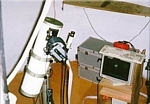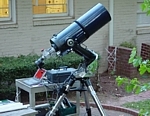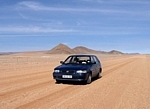Below are general recommendations to make the most of an astronomical observation. For this purpose, those that apply to observation homely (e.g. patio, balcony, terrace, etc.) are marked with a red circle [????], and those that apply for observation abroad (desert, field, mountain, etc.) are marked with a green circle [????]; If the recommendation applies to both types, it is indicated with both circles [????????].
Make yourself a workstation [????]
Take advantage of the observations you make from your patio/balcony, and make a small workstation to have at hand all the implements you are going to use: eyepieces, filters, motor, red flashlights, sky charts, notebooks, webcam, notebook, warm clothing and hot food and drinks for the cold... Some hobbyists even set up their own observatories in the patio, but this largely depends on the resources available. The important thing is to have everything you need to observe in one place.
Prepare the place????]
Your observation point at home should be as adapted as possible to night observation. Make sure you have no obstacles on the ground that interrupt the passage (e.g. cables), place yourself in the place where the least amount of light pollution reaches and hopefully place the telescope on a solid, upright surface that is easy to maneuver. It is also convenient to have quick access to a place to shelter the telescope and protect it from dust or dew, if you finish observing in the middle of the night.
Make a checklist [????]
If you are going out of town, prepare in advance (and keep for future trips) a list of everything you need for a typical observation; from the most basic things like binoculars or telescope, to the smallest things like spare batteries for the flashlight. All accessories must be duly noted as an inventory, because when you leave the place you must make sure that nothing was left there. Warm clothing and hot food and drink are also essential, especially for long observations.
Ensures transportation and observation location [????]
It is very important that the vehicle to go out of the city is in good condition, has enough fuel and is suitable for terrain that may be rocky and very cold at night; Likewise, the observation site must be previously verified, during the day, and it must be verified, as far as possible, that at night it offers good visibility conditions and is not affected by external problems (e.g. nearby vehicular traffic).

